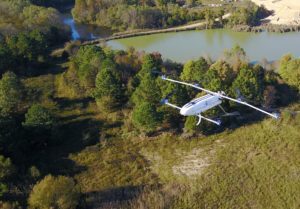
Hybrid Electric UAV: AAC Selected by AFWERX to Develop Next-Gen Tactical UAS
by DRONELIFE Staff Writer Ian M. Crosby
The United States Air Force (USAF) AFWERX program has selected hybrid-electric unmanned aircraft systems developer Advanced Aircraft Company (AAC) for the development of Small Unmanned Aerial Systems (SUAS) as part of the Small Business Innovation Research (SBIR) program Open Topics 21.2/B Cohort.
In collaboration with the Air Force Research Lab (AFRL) and the National Security Innovation Network (NSIN), AFWERX developed the SBIR Open Topics to improve upon the effectiveness and transition rate of the SBIR program. Using a competitive awards-based program, the SBIR program allows small businesses to explore their technological potential and offers an incentive to profit from its commercialization.
AAC’s flexible HAMR UAS uses a multi-rotor configuration with a hybrid fuel-electric propulsion system for extended endurance and multiple, simultaneous payload capabilities, and is able to be optimized for a wide range of defense applications and mission profiles. The HAMR also works as a force multiplier, granting a major increase in ISR capabilities corresponding to DoD’s incumbent tactical ISR UAS.
“We are thrilled to be part of the SBIR program Open Topics 21.2/B Cohort and look forward to a successful collaboration with our stakeholders,” said AAC Founder Bill Fredericks. “Our HAMR UAVs high-performance and efficient propulsion system, rugged aerodynamic airframe, and ease of serviceability in the field make it ideally suited for demanding military operations in the most inhospitable environments.”
The Hybrid Electric UAV Advantage
HAMR offers a flight time of up to 3.5 hours – six times longer than a conventional battery-powered multirotor aircraft. Featuring multiple redundant systems, remote in-flight engine starting, and onboard batteries, the aircraft is able to operate with a high margin of safety. Should engine or electric motor failure occur, the craft is able to abort, maneuver away, and land safely.
The model makes use of line replaceable units (LRUs), guaranteeing quick, reliable in the field servicing with minimal training, enabling minimum operational downtime. The aircraft’s service life is extended with a continuous development program that increases its capabilities with the integration of new technologies.
The HAMR’s dual payload bays are able to carry multiple sensors or devices simultaneously or, alternatively, allow for increased fuel capacity. The aircraft’s open modular architecture enables effecient payload reconfiguration depending on application and mission. Operators are able to select from a range of optical or infrared cameras and LiDAR systems, including standard Group 2 payloads for defense applications such as electro-optical (EO), infrared (IR), laser, and communications systems.
The HAMR is also highly portable and able to be launched within minutes with no ground support infrastructure. The system can be disassembled and stored in a single case and easily transported in a conventional civilian or small military vehicle.
Read more about hybrid UAV:
- Hybrid-Electric Generator Systems Help Drones Fly Farther and Carry Heavier Payloads
- 13 Hours, 4 Minutes: Skyfront Gas Electric Hybrid Flies 205 Miles for Longest Drone Multirotor Flight on Record
- Hydrogen-Hybrid Drones are Taking Off in Australia
Miriam McNabb is the Editor-in-Chief of DRONELIFE and CEO of JobForDrones, a professional drone services marketplace, and a fascinated observer of the emerging drone industry and the regulatory environment for drones. Miriam has penned over 3,000 articles focused on the commercial drone space and is an international speaker and recognized figure in the industry. Miriam has a degree from the University of Chicago and over 20 years of experience in high tech sales and marketing for new technologies.
For drone industry consulting or writing, Email Miriam.
TWITTER:@spaldingbarker
Subscribe to DroneLife here.